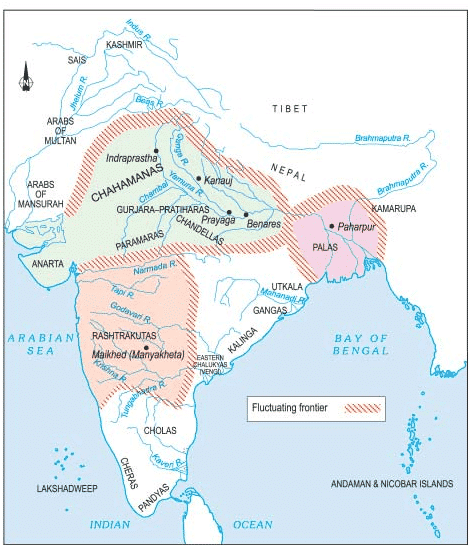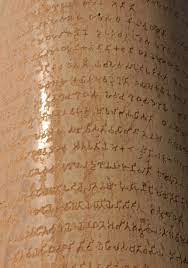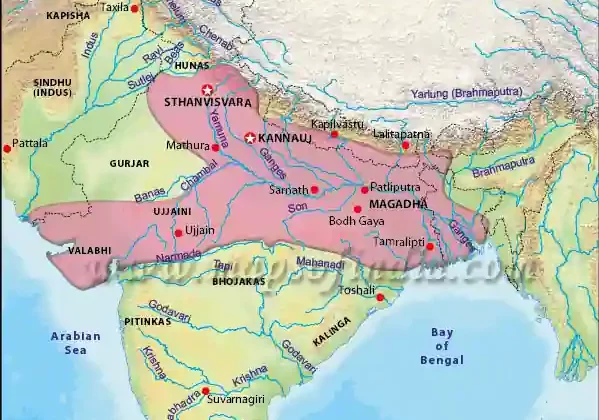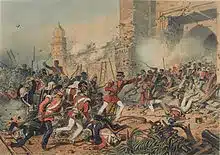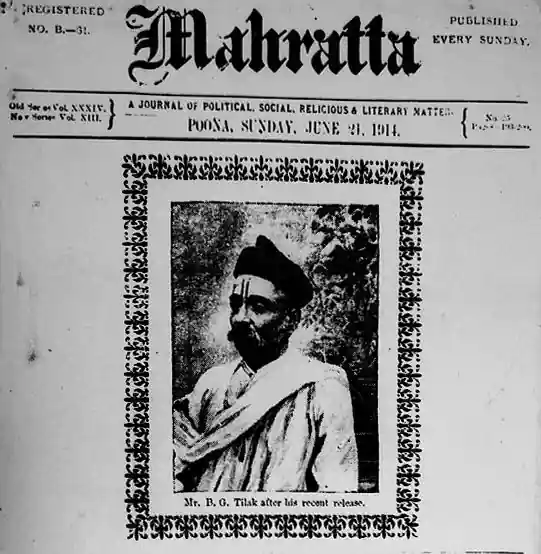Saptanga Theory of State
In Arthashastra, the concept of Saptanga Rajya has been mentioned which means that a state comprises seven interrelated and interlocked angas or prakritis (elements).
King (Svamin)
- Soul of all the seven elements.
- According to Kautilya, the king was the Dharma Pravakta or promulgator of the social order, as he issued Rajasasana i.e, royal rescripts and maintained Porana Pakiti i.e, ancient rules and customs.
- He was assisted by a council of ministers but he took final decisions by himself regarding law and order, revenue, war, etc.
- In one of his rock edicts, Ashoka had declared that even common people could meet him anytime.
- The king had to exercise great vigilance to safeguard his life and position. Various types of spies collected intelligence and reported the same to the king.
- The special reporters of the king Pativedakas and Pulisani kept him informed of public opinion.
Amatya (Bureaucrats)
- The Arthashastra refers to the highest functionaries at the centre as the eighteen Tirthas, the chief among them were the Mantrin (chief minister), Purohita (high priest), Yuvaraja (heir-apparent), and Senapati (commander-in-chief).
- The officials who were in-charge of other important portfolios were known as Amatyas (who filled the administrative and judicial appointments), Mahamattas, and Adhyakshas.
- The state appointed 27 Adyakshas (Superintendents) mostly to regulate the economic activities of the state.
- They controlled and regulated agriculture, trade and commerce, weights and measures, crafts such as weaving and spinning, mining, etc.
- The Samaharta was the highest officer in charge of assessment and Samadhata was the chief custodian of the state treasury and store house.
Janapada (Territory and Population)
- The Mauryan empire was divided into four provinces, apart from Magadha with its capital at Pataliputra. During the reign of Ashoka, a fifth province of Kalinga was incorporated.
- Uttarapatha (northwestern India) – capital at Taxila
- Dakshinapatha (southern India) – capital at Suvarnagiri
- Eastern India – capital at Tosali
- Avantiratha – capital at Ujjain
- Kalinga – capital at Tasali/Dhauli
- The head of the provincial administration was the Viceroy, who was in charge of law and order and collection of taxes from the centre.
- He was generally a prince from the royal family (Kumara or Aryaputra) and was assisted by Mahamattas and a council of ministers.
- The provinces were further divided into divisions headed by Pradeshikas (with no advisory council).
- Divisions were divided into districts headed by Rajukas (rajju means rope and refers to the measurement of land using ropes). He was assisted by Yuktas.
- Districts were divided into groups of 5 or 10 villages headed by Sthanikas (who collected taxes), who were assisted by Gopas (maintained proper records and accounts).
- The lowest unit of administration was the village, headed by Gramini/Gramika on the consultation of Grama Vriddhas (elders of the village).
- The administration was thus, in the nature of a pyramid with the Gramini at the bottom and the King at the top.
- As per the sources- Megasthenes and Arthashastra, the city administration of Patliputra was conducted by six committees of five members each.
- Each committee was given different subjects like industry, foreigners, trade and market, etc.
Durg (Fortified capital)
- The Mauryans maintained a huge army. Anta-Mahamattas (higher officials) were responsible for the security of frontier forts.
- Kautilya gave detailed directions for the construction of the main fort in the capital city. He recommends that troops should be stationed along the approaches to the fort and the fort walls should be surrounded by not one but three moats filled with lotuses and crocodiles. He also suggests that the fort should be provided with plenty of supplies to tide over sieges and should have numerous secret escape routes.
- Kautilya strongly approves an adequately trained standing army, which was supposed to be recruited from all four varnas and maintained by the state.
- Megasthenes reports that the administration of different branches of the army was carried through a war office comprising 30 members. It was divided into six boards of five members each:
- The board of Admiralty – In charge of the navy (though Kautilya does not mention the navy).
- The board of Infantry – Headed by Padadhyaksha.
- The board of Cavalry – Headed by Asvadhyaksha.
- The board of War Chariots – Headed by Rathadhyaksha.
- The board of War Elephants – Headed by Hastyadhyaksha.
- The board of Transport and Supervision of Equipment
- In addition to these, there is mention of periodic levies of troops like Maula (hereditary warriors), Bhartiakas (mercenaries), and forest tribe soldiers, and allies (furnished by friends).
Kosha (Treasury)
- Land revenue was the major source of income.
- Peasants had to pay one-sixth of the produce as bhaga and the extra tax bali as tribute.
- Peasants had to pay many other taxes like Pindakara (assessed on a group of villages), Hiranya (paid only in cash), Kara (levied on fruits and flower gardens), etc.
- The class of officials who collected land tax was called Agranomoi (Megasthenes).
- However, there is no reference in any text of taking away the land of the farmers in case of non-payment of taxes.
- Kautilya also mentions certain emergency taxes (Pranaya) or the additional taxes that the state could impose if the treasury got depleted.
- Craft activities were also an important source of revenue to the state.
- Artisans living in the town had to pay taxes either in cash or kind or work free for the king (visthi- forced labour).
- There is mention of karamakara who were regarded as free labourers working for a regular wage and the dasas who were slaves.
- Traders and artisans were organised into corporate associations called shrenis or guilds or puga to protect their rights and these guilds were headed by Jesthaka.
- The state-run textile workshops were placed under Sutradhyaksha and chariot workshops under a Rathadhyaksha.
- Mining and metallurgy were other important economic activities and the mine officer was called Akaradhyaksha.
- The Mauryans maintained a monopoly over the production of iron, which was in great demand by the army, industry and agriculture. The officer-in-charge was named Loha-adhyaksha.
- Trade routes in the Mauryan period followed either the main highways or the navigable rivers. Urban taxes included Shulka (duties on imported and exported goods) and excise duties on local manufacturers.
- The use of currency became a fairly common feature of the Mauryan period.
- The punch-marked silver coins, carrying the symbols of the peacock, hill and the crescent (called pana) formed the imperial currency.
- Kautilya refers to the state officer-in-charge of coinage as Rupadarshaka.
- About the practice of usury, Megasthenes states that Indians neither put out money at usury (lending of money at high-interest rates) nor knew how to borrow.
Thus during the Mauryan reign, there was extensive participation of the state in the economy and the state exercised great regulation and control over the economy.
Danda/Bala (Justice/Force)
- The king was the head of justice – the fountainhead of law and all matters of grave consequences were decided by him.
- Kautilya refers to the existence of two types of courts – Dharmasthiyas (dealing with civil matters) and Kantakasodhanas (dealing with criminal cases).
- Judges were called Dharmasthas, though Ashokan inscriptions mention city Mahamattas who were also given judicial functions.
- The Pradeshtris were the officers responsible for the suppression of criminals.
- Kautilya mentions about four sources of law:
- Dharma (sacred law)
- Charitam (customs and precedents)
- Vyavahara (usage)
- Rajasasana (royal proclamations)
Mitra (Ally)
Kautilya lists six policies (Shad-gunya) to be followed by the king under these circumstances:
- Policy of Sandhi (peace treaty) – If one is weaker than the enemy.
- Policy of Vigraha (hostility) – If one is stronger than the other.
- Policy of Asana (keeping quiet) – If one’s power is equal to that of the enemy.
- Policy of Yana (marching on a military expedition) – If one is much stronger than the enemy.
- Policy of Samshraya (seeking shelter with another king or in a fort) – If one is very weak.
- Double policy of Dvaidhibhava (sandhi with one king and vigraha with another) – If one can fight the enemy with the help of an ally.
The Mauryas had great diplomatic relations with various Hellenistic kingdoms and even South Asian countries. It seems that they had a department of foreign affairs. In Arthashastra, there is a mention of certain diplomatic posts of Nisriharthaduta, Parimitarthaduta, Sasanharaduta.
About Kautilya

- Chanakya (375–283 BCE) was an ancient Indian polymath who was active as a teacher, author, strategist, philosopher, economist, jurist, and royal advisor.
- He is traditionally identified as Kauṭilya or Vishnugupta, who authored the ancient Indian political treatise, the Arthashastra, a text dated to roughly between the fourth century BCE and the third century CE.
- As such, he is considered the pioneer of the field of political science and economics in India, and his work is thought of as an important precursor to classical economics.
- Around 321 BCE, Chanakya assisted the first Mauryan emperor Chandragupta in his rise to power and is widely credited for having played an important role in the establishment of the Maurya Empire.
- Chanakya served as the chief advisor to both emperors Chandragupta and his son Bindusara.
About Arthshastra
The title Arthashastra, a Sanskrit word, literally means ‘the science of material wellbeing’, though it is also accepted as ‘the science of statecraft’. It is rather interesting to note that according to the Arthashastra, artha, i.e., material well-being, is superior than both dharma (spiritual well-being) and kama (sensual pleasure).
- It consists of 15 books (Adhikaranas), out of which the first five deal with tantra (internal administration), and next eight with avapa (interstate relations). The final two books deal with other miscellaneous topics.
- The Arthashastra summarises the political thoughts of Chandragupta Maurya’s chief minister Kautilya, also known as Chanakya or Vishnugupta, who is often compared to the Italian Renaissance writer Niccolo Machiavelli (the author of The Prince).
- This book was lost for many centuries until a copy of it, written on palm leaves, was rediscovered in 1905 CE by the Sanskrit scholar Rudrapatna Shamasastry (l. 1868-1944 CE). Shamasastry published the work in 1909 CE and then translated it into English and published that version in 1915 CE which brought it greater attention.
- This edition is dated to approximately c.250 CE, many centuries after the time of Kautilya, but it is generally accepted that the main ideas in this book are largely of Kautilya himself.
- The book contains detailed information about specific topics that are relevant for rulers who wish to run an effective government.
- Diplomacy and war (including military tactics) are the two points treated in most detail but the work also includes recommendations on law, prisons, taxation, irrigation, agriculture, mining, fortifications, coinage, manufacturing, trade, administration, and spies.
- The ideas expressed by Kautilya in the Arthashastra are completely practical and unsentimental.
- Kautilya openly writes about controversial topics such as assassinations, when to kill family members, how to manage secret agents, when it is useful to violate treaties, and when to spy on ministers. However, he also writes about the moral duty of the king and stresses on paternal despotism as he summarises the duty of a ruler, saying, “The happiness of the subjects is the happiness of the king; their welfare is his. His own pleasure is not his good but the pleasure of his subjects is his good”.
- According to Kautilya, the ruler should use any means to attain his goal and his actions required no moral sanction.
Related topics:


